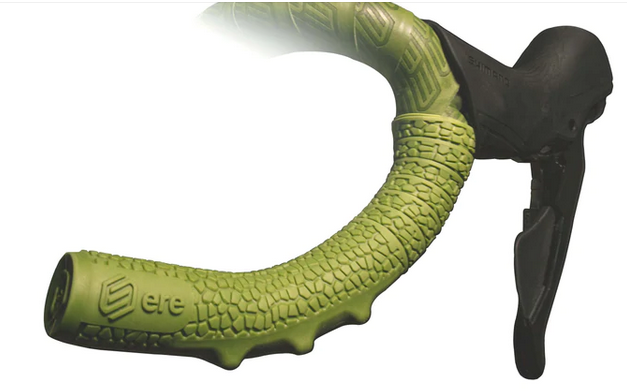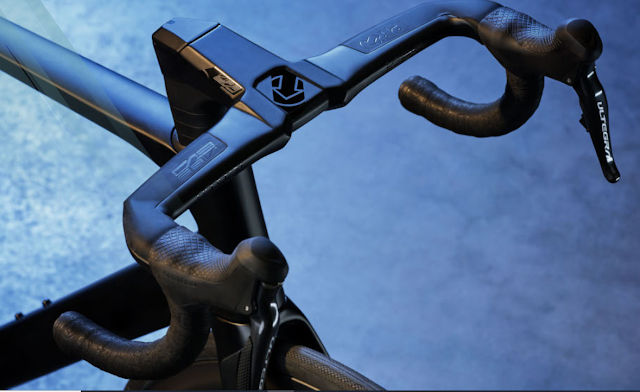 |
| The Redshift Sports Cruise Control Grips |
Well, there are "drop bar specific grips" from several companies and they are starting to catch on. I saw where Jay Petervary was using some of the Redshift Sports Cruise Control grips on that longtail Esker bike. That's a pretty high-profile endorsement of such a grip for long gravel rides.
But Redshift isn't the only idea out there. I used some longer ESI silicone grips on my Pofahl briefly back more than ten years ago to try to find some relief from the gravel. For myself, that didn't work so well, but those are still a good idea for some folks. Now Ritchey Design has a similar grip out for drops in their WCS Drop Bar Grips.
 |
| The Ritchey WCS Drop Bar Grip (Image courtesy of Ritchey Design) |
To my way of thinking the best design for a drop bar grip is more like an Ergon grip, but not everyone may agree with me there. That said, you've got two basic choices in grips with a variation that could be seen as a third variation on the theme, I suppose. then you also have shaped handle bars, which are a separate component and which have their own sets of plusses and minuses for the gravel rider.
The Ritchey Design grip is representative of what I call "track bar style grips". Grips that go on a drop bar's extensions and maybe as far as up to the lever clamp. There are certainly those who may think, "Just buy a track grip!", and be done with it. Well, that is an option, but the gravel influence usually means that this sort of grip has some "beef" to it and that it is designed to absorb vibrations. That's the idea behind the Ritchey grip.
 |
| My Pofahl custom signature bike with the original set-up featured ESI silicone grips on the drop bar. |
The other variation on this "track bar style grip" is similar but they have "ergonomic bumps" to aid in grip on the drop bar's extensions. I haven't seen a lot of this sort of thing, but examples do exist and I have photographic evidence to share below.
 |
| ERE Research grips |
 |
| The "Shape My Grip" accessory grips fit over the bar and then are wrapped over. |
My feelings on this sort of adaptation to drop bars is that they don't really do anything for vibration reduction. The may give you a bit more purchase on the bar in slippery situations, but most of the time they aren't doing much for you.
And maybe that is a criticism to be leveled at all of the solutions I've presented so far, because, ya know, most folks are riding on the hoods a large percentage of the time that they are on the bike. Things down on the extensions aren't of much use to them. That's why shaped bars have become more popular.
 |
| The PRO brand "Vibe" bars (Image courtesy of PRO) |
Shaped, "ergonomic" bars, especially carbon handle bars, are very popular because the manufacturer can put the "comfort features" closer to where riders will actually use that. The "tops" section is probably the most commonly affected section of a drop bar in that regard, but the PRO branded "Vibe" bar takes this to an extreme because they have designed that bar to mate with Shimano levers. Understandably so, since PRO is owned by Shimano!
The thing is, the ergonomic bar has two things going against it. One: The angles and positioning overall of any ergo features are not adjustable. Either you get on with what the designer did, or you do not. The expense of such handlebars makes risking choosing one a harder thing to do. Two: We are hamstrung by the brake lever clamp standard which has been in use for a century and dictates the way we attach levers and therefore it makes any radical changes to the bar shape tough to accomplish.
 |
| Because Whisky designed the Mason Bar to have MTB sized extensions, I was able to mount these Ergon grips. |
So, at this point grip technology for drop bars is kind of at a standstill. To my way of thinking, although many people don't ride in the drops, the Redshift Sports Cruise Control grips are still the best thing I've come across for comfort and vibration reduction for drop bars. Yes, the fact that they are very "ergon-like" is not lost on me. But it only makes sense that this is what should be pursued for that particular position on the bars.
I love the more integrated idea that PRO used on the Vibe bar which transitions the lever to the bars well. That's probably the smartest place to work on for other companies to innovate in because of all the time most people's hands are on the hoods or right there where the lever connects to the bar.
Time will tell if anybody comes up with some solutions, but I think this is an area ripe for the taking in the gravel market now.

Last year I tried the Ritchey Beacon bar on my Fargo and that bar totally changed my riding. I'm now almost exclusively in the drops and the ends. Since that bike is set up for everything from really rough double track to tight singletrack I feel like I finally have full control in rough terrain vs sitting on the hoods. This year I decided to try the Ritchey Gravel Grips and I've come to the same conclusion as you - I'm not feeling much more in the way of extra cushioning, but for the Ritcheys at least they offer a lot more predicable grip than other tapes that I've tried.
ReplyDeleteAn extra benefit for me at least is durability. Since I use that bike in tight singletrack my bar ends tend to deflect a good amount of branches and tree trunks, which shreds bar tape. The Gravel grips have so far withstood a lot more physical abuse without complaining, so points there.
@ wp - Thanks for that perspective. I've looked at the Beacon Bar and thought it might make a good gravel riding bar. Good to hear that you like it.
ReplyDeleteI hadn't thought about the single track issues with drop bar extensions, but that is a great selling point for grips like the Ritchey Gravel Grip.